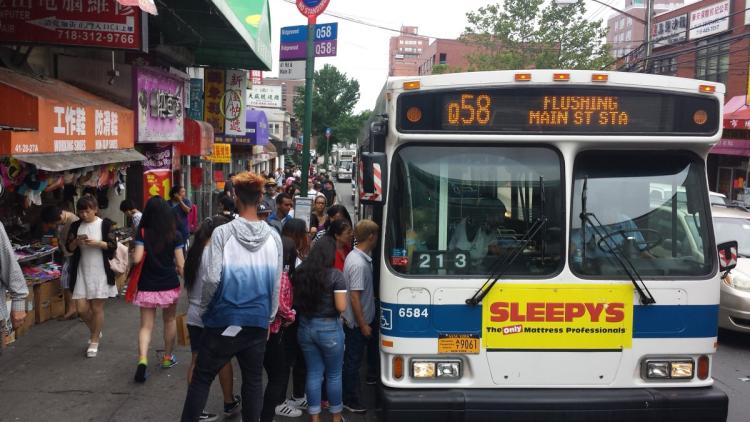
Governor Cuomo’s command that the MTA become more open to new ideas could mean relief to NYC’s 2 million daily bus riders.
Last week Governor Cuomo acknowledged the sinking performance of the Metropolitan Transit Authority, and even declared a “State of Emergency.” He and his new appointee, Chair Joe Lhota, are now recognizing that the problems are their responsibility to solve. Their new candor about operational shortcomings is a welcome change, but there’s one area of MTA operations that is ripe for quick improvement now rather than later: bad bus service. Two million New Yorkers were conspicuously left out of the Governor and the Chair’s mea culpas – the two million New Yorkers who use the MTA’s deteriorating bus service. They are disproportionately elderly and lower-income, and have been suffering from declining service for years, not just months.
Yet those people – New York City bus riders, about three times the population of Buffalo, Rochester and Syracuse combined – represent Cuomo’s and Lhota’s best opportunity for some quick wins, because MTA’s bus woes could be fixed relatively cheaply and quickly. There’s an additional operational upside, too: in cities like London and Seoul, improved bus networks take some crowding pressure off the subway, because some people are willing to choose a bus as an alternative when the service is good. New York has that opportunity in some obvious corridors, for example by diverting the riders who currently take subways from Brooklyn into Manhattan and then back out to Queens because the transit service directly from Brooklyn to Queens is so inadequate.
Even before NYC subways entered this era of service meltdowns, the system was showing signs of reaching its effective passenger capacity. Because subway capacity is so hard to expand, booming cities like London and Seoul have executed deliberate bus capacity and service quality efforts alongside (or literally perpendicular to) subway improvements to continue to meet travel demand with a range of public transit modes. As a result of these improved options, bus ridership has soared in those cities while it has declined in NYC. Today, more Londoners travel by bus than by the Tube.
The NYC Bus Turnaround coalition has issued a set of technical recommendations showing how the MTA can emulate those successful cities. Governor Cuomo’s “emergency” adds to the urgency of what we already know:
- While some apologists attribute poor MTA performance to overcrowding, NYC transit use was actually down somewhat in 2016. Subway use dropped slightly from 2015 to 2016, while bus use continued steadily downward, and is in fact down significantly from 2010 to 2016

- Transit ridership is not keeping pace with population. Bus ridership per capita is down significantly and subway ridership per capita is flat.

- Transit use is not keeping pace with employment. Both bus and subway ridership per job in the city is down (job figures for 2016 not yet available).

Where are these riders going? A recent study by transit expert Bruce Schaller found that Uber and other ride-hailing services accounted for 600 million miles driven in New York City alone last year, likely contributing to the increasing congestion on city streets. If frustrated commuters continue making this mode-shift, gridlock will render New York City a much less attractive place for companies to do business. At what point does lousy transit begin to affect our city’s growth trends and economic viability?
Crisis breeds opportunity, and NYC’s buses should play a starring role. In very short order, Governor Cuomo and Chair Lhota should direct the Metropolitan Transportation Authority to expand off-the-bus fare collection, enabling people to board through all doors on high-ridership routes where long delays for getting on and off buses are an everyday, every-stop fact of life. He should also insist that the MTA implement all-door boarding on all routes when the MetroCard fare payment system is replaced in a few years. Local elected officials should embrace bus-only lanes at proven choke points in their districts, even when a vocal minority complains. A bus route that carries ten or twenty thousand people per day should not be slowed simply for the convenience of a handful of motorists. Curb and lane space that can serve tens of thousands of New Yorkers on buses should not be devoted to the storage of private automobiles. And the MTA should work with the NYC-DOT to implement transit-signal priority, a proven time-saving technology, at intersections across the city starting this summer. It won’t take a gazillion dollars, and it won’t take decades. The benefits will be recognized by riders quickly, and the political credit will flow to the Governor just as fast as the angry Tweets reach him today.
While it’s important that the MTA begin the long, difficult work to improve the subways, a transit comeback story has to include New York City’s buses as an essential component.
 On the Brink: Will WMATA’s Progress Be Erased by 2024?
On the Brink: Will WMATA’s Progress Be Erased by 2024?
The experience of being a WMATA rider has substantially improved over the last 18 months, thanks to changes the agency has made like adding off-peak service and simplifying fares. Things are about to get even better with the launch of all-door boarding later this fall, overnight bus service on some lines starting in December, and an ambitious plan to redesign the Metrobus network. But all of this could go away by July 1, 2024.
Read More A Bus Agenda for New York City Mayor Eric Adams
A Bus Agenda for New York City Mayor Eric Adams
To create the “state-of-the-art bus transit system” of his campaign platform, Mayor Adams will have to both expand the quantity and improve the quality of bus lanes. We recommend these strategies to get it done.
Read More